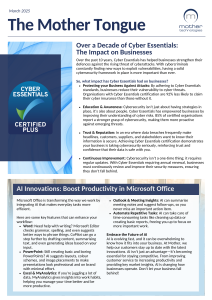
Ethernet is delivered over fibre optic circuits and offers speeds anywhere between 3Mbps to 10Gbps depending on whether circuits are completely fibre from end to end – and what quantity of bandwidth you are willing to pay for.
The difference with optic fibre circuits is that there is no resistance and loss of speed over distance as happens with copper wire, meaning data speeds are extremely reliable and quick over any distance. Ethernet is what we recommend for the majority of business purposes, particularly for multi-site connectivity or organisations with heavy data requirements.
You can purchase Ethernet in a variety of options, some of which are more suitable than others based on the volume of your data connectivity requirements, your budget and location. Although all Ethernet services will offer uncontended usage of agreed bandwidth, meaning you get guaranteed speeds at all times, and guaranteed response/fix times should your line go down.
See this datasheet for a quick summary of speeds and prices available with each service.
This service offers fast, guaranteed symmetrical speeds, but is more cost effective than either Ethernet First Mile (EFM) or end to end Ethernet.
It requires your local cabinet to already have a fibre connection installed. Openreach are currently rolling out fibre services across the UK depending on how many potential customers are in range of the local cabinets.
It is delivered by a combination of copper and fibre circuits. Existing copper circuits are used to reach your local cabinet, but then fibre is used from your local cabinet to the nearest exchange. This allows for quicker installation times than full Ethernet because new circuits are not required – as long as the local cabinet is already equipped for Ethernet services.
Maximum speeds available are 20Mbps. You can choose what quantity of bandwidth you’d like with the option to scale this up in future on the existing circuit infrastructure.

The Lite version of FTTC is a low price alternative to the full service bandwidth, still guaranteeing symmetrical upload and download speeds on uncontended circuits. Although not particularly suitable for combined voice and data or cloud connectivity requirements, it can suitably accommodate the needs of a couple of workers in a small business or branch office. Lite services offer speeds of 3Mbps.
EFM is for businesses which do not have access to a local cabinet with fibre connection. It comes in EFM4 and EFM2 variations. It is delivered over copper circuits from your local cabinet to the nearest Exchange using multiple bonded pairs of copper wire, making it more resilient than a normal broadband connection.
It offers more bandwidth, and if one copper pair fails your service is till delivered over another pair. Because speed is lost over distance on copper, the speed of your service will depend on the distance from your local exchange.
EFM4 indicates that 4 copper pairs are used, providing greater bandwidth and service resiliency than the EFM2 service. It can comfortably accommodate businesses with combined voice, data and cloud connectivity needs. Speeds of up to 20Mbps can be delivered.
The Lite version provides the same benefits as the full service with EFM4 resiliency, but for lower data requirements and at a lower price point. It would not necessarily be suitable for combining voice and hosting requirements depending on how many people are using it. Lite services offers speeds of 3Mbps.
EFM2 uses 2 bonded copper pairs to deliver a symmetrical, uncontended connection. It is suitable for combined voice and data, or accessing cloud services, but at a lower bandwidth requirement and price than EFM4. Speeds of up to 10Mbps can be delivered.
EFM2 Lite is the cheapest option in the range of uncontended circuits, offering all benefits such as guaranteed speeds, symmetrical upload to download speed and service level agreements in case of failure but with less resiliency and bandwidth than other options. It would not necessarily be suitable for combining voice and hosting requirements depending on how many people are using it. Lite services offer speeds of 3Mbps.

Read the newest edition of The Mother Tongue, packed with fresh tech insights and company updates.
